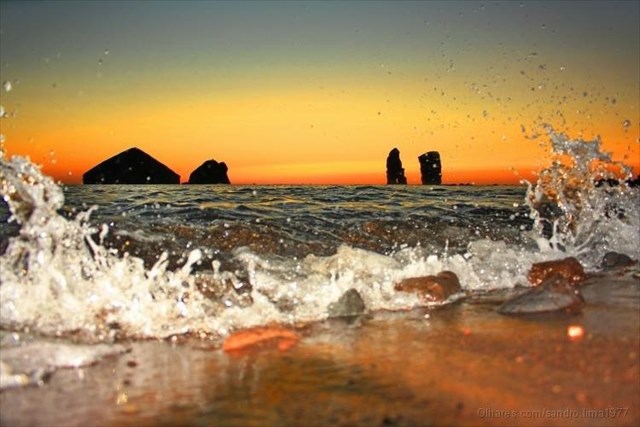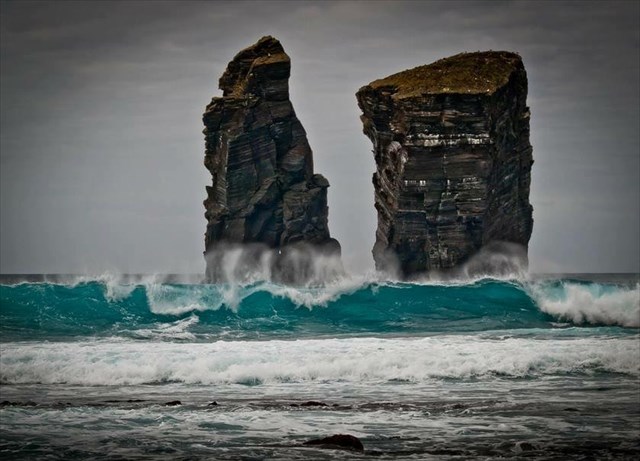
OS ILHÉUS DOS MOSTEIROS

[S. Miguel – Azores]


EARTHCACHE

PORTUGUÊS

Esta earthcache foi considerada, pela Groundspeak, em setembro de 2018, e relativamente ao Dia Internacional das Earthcaches, como uma das:
“10 Stunning EarthCaches from Around the World”

|
“EarthCaches bring you to unique locations and teach fascinating geological lessons about Planet Earth”

|
Os Ilhéus dos Mosteiros

Os ilhéus dos Mosteiros são um conjunto de quatro grandes rochedos existentes a cerca de meia milha náutica da costa da freguesia dos Mosteiros, no extremo ocidental da ilha de São Miguel, Açores. São os restos desmantelados pela erosão marinha de uma pequena ilha formada por um cone litoral de origem hidromagmática, fortemente palagonitizado.
Dentro da tradição céltica do monasticismo em rochedos oceânicos, estas rochas deram o nome de Mosteiros à freguesia vizinha. Com uma altitude máxima de 72m (metros), constituem uma atração turística daquela freguesia, que a eles deve o seu nome. Os ilhéus dos Mosteiros são a sua característica mais conhecida, tendo mesmo dado origem ao nome da freguesia, pois os descobridores, notando a forma peculiar destas estruturas, associaram-na a um enorme "casarão", ou convento de frades, daí o nome de Mosteiros.

A GEOLOGIA DOS ILHÉUS DOS MOSTEIROS

No entanto, a origem geofísica dos ilhéus difere da fajã dos Mosteiros. De facto, uma observação atenta dos mesmos leva-nos a concluir que foram separados da rocha em época muito mais longínqua, devido à sua constituição e forma. O ilhéu dos Mosteiros é formado por tufos palagoníticos. Estes tufos basálticos, são muito compactos; sendo o seu material constituinte, muito urdido. No passado este material foi usado em construções militares e em “ombreiras de portas”. Constitui parte de um cone vulcânico, na sua quase totalidade desmantelado pela abrasão marinha.


Os Ilhéus dos Mosteiros, apesar de serem muito mais antigos, são semelhantes a vários outros ilhéus açorianos, nomeadamente: ilhéu de Vila Franca, “Monte da Guia”, Ilhéu do Rosto do Cão (em S. Roque), ilhéu de Monchique, etc…
Estes ilhéus são o “resto” de um ilhéu “Surtsyano/Capeliano” e provém da falha do Graben das Sete Cidades e de uma erupção “parasita radial do Vulcão das Sete Cidades. Situam-se na ponta da ilha, sofrendo o efeito de fortes correntes de vazão, quer de norte, quer de sul. A atual forma destes ilhéus, resulta da erosão marinha (abrasão), sob o efeito, quer do vento, quer do mar.

PARA REALIZAR E REGISTAR ESTA EARTHCACHE:
PERGUNTAS:
Para “encontrar/registar” esta cache deverá: provar que esteve no local e responder às seguintes questões, enviando um email/mensagem de Geocaching, com as respostas, em português ou em inglês, para o nosso perfil.
Só depois, de enviar as respostas, e conforme as “guidelines” para as Earthcaches, deverá efetuar o seu registo!
Serão removidos todos os registos que não obedeçam a estes requisitos.
1. Com base no tema desta earthcache, responda às seguintes questões:
a) Que tipo de rocha é predominante nestes Ilhéus?
b) Há muito tempo no local existia parte de um cone vulcânico; hoje separado em quatro ilhéus. Diga qual a principal razão responsável pela separação deste cone em vários ilhéus.
c) Como se formaram estes Ilhéus?
2. A partir das suas observações, no local do GZ, responda às seguintes questões:
a) O ilhéu situado a oeste do GZ, tem alguma falha?
Se sim, é vertical ou horizontal?
b) Qual é a cor (ou cores) visíveis na escarpa visível a partir do GZ no ilhéu maior (“Mosteiro”)?
c) Explica por que razão algumas rochas desta escarpa são avermelhadas?
d) Classifica quanto à dureza e porosidade as rochas da parede desta escarpa.
3. TAREFA OBRIGATÓRIA:Deverá tirar uma foto sua, onde você apareça (ou com um papel/placa onde conste o seu nickname e a data da visita) e que comprove a sua presença no GZ desta EC - NÃO METASPOILERS. Esta foto deverá ser colocada no seu registo ou enviada por email ou sistema de mensagens de Geocaching, para o owner!

ATENÇÂO: a partir de de 26 de janeiro, todos os registos, que não tenham a foto comprovativa da visita ao local, serão apagados.
Não responderemos ao seu contato, a não ser que haja algum “problema” com as suas respostas ou registo.




“MOSTEIROS” ISLETS
[S. Miguel - Azores]

ENGLISH

EARTHCACHE

This earthcache was considered, by Groundspeak, in September 2018, and for the International Earthcaches Day, as one of:
“10 Stunning EarthCaches from Around the World”

|
“EarthCaches bring you to unique locations and teach fascinating geological lessons about Planet Earth”

|
“Mosteiros” Islets

The islanders of the Monasteries are a set of four existing large rocks about half a nautical mile from the shore of the parish of the Monasteries in the western end of the island of Sao Miguel, Azores. Are dismantled remains by marine erosion of a small island formed by a coastline cone hidromagmática origin, strongly palagonitizado.
Within the Celtic tradition of monasticism in oceanic rocks, these rocks they named Monasteries the neighboring parish. With a maximum altitude of 72m (meters) constitute a tourist attraction that parish, that they owe their name. The islanders of the Monasteries are its best-known feature, and has even given rise to the name of the parish, as the discoverers, noting the peculiar shape of these structures, associated it to a huge "big house", or convent of friars, hence the name monasteries.

GEOLOGY OF “MOSTEIROS” ISLETS


However, the geophysical origin of the islanders differs from fajã of the Monasteries. In fact, a careful observation of them leads us to conclude that were separated from the rock in time much more distant, because of its constitution and form. The islet of monasteries consists of palagoníticos tufts. These basaltic tuffs, are very compact; and its constituent material, very warped. In the past this material has been used in military buildings and "door jambs". It is part of a volcanic cone, almost entirely dismantled by the marine abrasion.

The islanders of the Monasteries, although they are much older, are similar to several other Azorean islanders, including: islet of Vila Franca, "Monte da Guia" islet dog's face (in San Roque), etc ...

These islets are the "rest" of an islander "Surtsyano / Capeliano" and comes from the Graben fault of the Seven Cities and a rash "radial parasite Volcano Seven Cities. They are located on the edge of the island, suffering the effect of strong currents flow, either north or south of. The current form of these islanders, results of marine erosion (abrasion), under the influence, wind or either of the sea.

TO PERFORM AND LOG THIS EarthCache:
QUESTIONS:
To "find / register" this cache must: prove that visited the site and answer the following questions by sending an email / message Geocaching, with answers (in Portuguese or in English, only) to our profile.
Only later, sending the answers, and as the "guidelines" for EarthCaches should make your registration!
They will be removed from all records that do not meet these requirements.
1. Based on the theme of this earthcache, answer the following questions:
A) What type of rock is predominant in these islands?
B) A long time ago there was part of a volcanic cone; Now separated into four islets. What is the main reason for separating this cone from several islets?
C) How did these Ilheus?
2. From your observations, at the GZ site, answer the following questions:
A) The islet located to the west of the GZ, has some flaw?
If yes, is it vertical or horizontal?
B) What color (or colors) are visible on the escarpment visible from the GZ on the largest islet ("Monastery")?
C) Explain why some rocks on this escarpment are reddish?
D) Rate the hardness and porosity of the rocks in the wall of this escarpment.
3. TASK (not optional): You must take a picture of yourself, where do you show up, (or with a paper / plaque with your geocaching nickname and the date of the visit) and that proves your presence in the GZ of this EC - no spoilers please. This photo must be placed in your log or sent by email or Geocaching messaging system, to the owner!

We do not respond to your touch, unless there is a "problem" with their answers or register.



